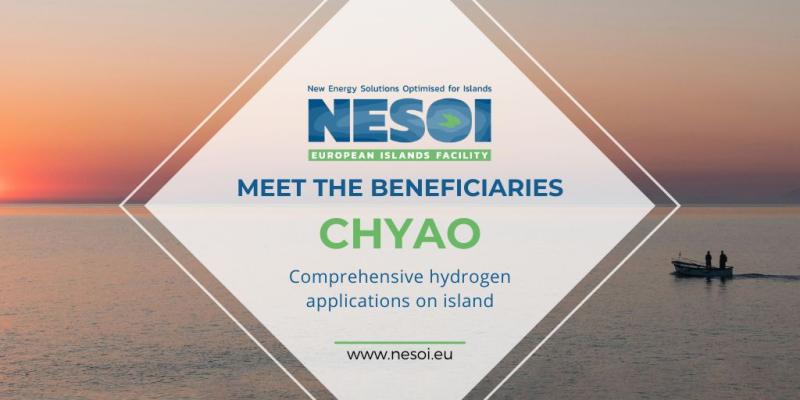Comprehensive hydrogen applications on island (CHYAO) is a project supported by NESOI European Islands Facility, managed by our partners from RINA, and promoted by Associazione Nazionale Comuni Isole Minori (ANCIM).
What is CHYAO?
The CHyAO project was designed around a white paper from ANCIM (Associazione Nazionale Comuni Isole Minori), entitled "Isole minors between sun, sea and wind," focusing on alternative energy sources like hydrogen. The study, conducted with university professors, found that minor islands are ideal for testing hydrogen intervention. The first island tested was Ventotene, and more will follow. A public event in October 2023 raised awareness among the population, municipalities, economic and social forces. The study also highlighted the potential of hydrogen production from seawater and waste, which could be used for ferries or private boats. ANCIM coordinated with 35 municipalities in smaller islands to ensure project replicability. The white paper also discussed streaming procedures, highlighting the revenue-generating sector and the unique needs of the Mediterranean islands. This is why hydrogen was chosen as the CHyAO technology.
The project aims at developing a comprehensive feasibility study to foster the green hydrogen (H2) uptake in small islands, with a focus on the Italian context. Green H2 is foreseen as the main future energy vector able to couple multiple sectors with a strong decarbonizing effect. CHyAO addresses green H2 use especially in the transport sector. The project consists of a techno-economic analysis of production and use of green H2; a study of available regulations and restrictions into hydrogen technologies; and the investigation into using green H2 in a ferry boat system connecting Ventotene and Santo Stefano.
The replicability on other islands is strongly foreseen since ANCIM has an extended network related to small islands representing 35 municipalities and more than 200,000 inhabitants. The CHyAO can also be adapted to different areas on the mainland especially remote, rural or especially coastal areas.
CHyAO: decarbonising small islands
Ventotene island has an area of 1.74 km2 and 700 permanent inhabitants. It is not connected to the mainland power grid, has strong seasonal tourism, and is part of a natural park. Similar conditions are shared with many Italian minor islands.
The installed power on the island is composed of 1,6 MWe from diesel generators, 150 kWp PV power (650 kWp forecasted in 2026) and 600 kWh Li-ion storage. There is already a fleet of 35 shared electric scooters and is planned also an e-bike service. Two electric charging stations have been installed in 2023, one for road vehicles and one for maritime traffic.
The local green hydrogen will be used to decarbonize local maritime traffic and waste disposal for pyrolysis activated with hydrogen, offering a new service to locals and tourists. Namely the CHYAO explores the possibility to fuel a ferry with local hydrogen to transport people between the neighbouring islands Ventotene and Santo Stefano with zero emissions.
The challenge to decarbonize maritime is very difficult, not only due to the scale of emissions but also due to uncertainty over the technologies. Commercially available fuel cells for Maritime applications are few. For instance, Ballard’s 200kW system, FCwaveTM, is designed to provide zero-emission power to vessels. The system is scalable from 200kW to MWs to suit a broad range of vessels operating on short or longer and demanding routes. The FCwaveTM is usedin the Norvegian ferry HYDRA.
Expected environmental impacts
Diesel costs in Ventotene are 21% higher than the mainland average. Producing green H2 on the island cuts the fuel transport costs and, potentially, also the cost of mobility in the island.
How does NESOI support this project?
The European Islands Facility (NESOI) aims to unlock the potential of EU islands to become the locomotives of European Energy Transition. To do so, NESOI aims to mobilize more than €100 million of investment in sustainable energy projects to give EU islands the opportunity to implement energy technologies and innovative approaches, in a cost-competitive way.
More specifically, NESOI has provided the following support to the project:
- Assessment of the key project sizing drivers taking also into consideration local constraints
- Identification of suitable technological options given existing project sizing requirements
- Definition of the required environmental permitting procedures given the identified project options
- Cost Benefit analysis and socio economic and environmental impact evaluation
- Definition of the technical, economic and financial, fiscal project inputs
- Risk analysis and identification of available mitigation strategies
- Assessment of existing procurement options (e.g. tender, PPP, etc.)
- Financial modelling and identification of target scenario
- Identification of financing/funding options, action plan and identification of project monitoring procedures
READ MORE INFORMATION IN THE DEDICATED PROJECT BROCHURE


